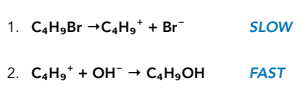Rate Equations - Reaction Determining Steps (A-Level Chemistry)
Rate-Determining Step of Reaction
The Rate Determining Steps (A-Level Chemistry)
• Chemical reactions can occur in multiple steps. Many reactions don’t actually occur all in one go as it might look from a chemical equation, they often occur in multiple steps.
• Usually the steps involve dependency. The reactant of one step is the product of the previous step, so each new step can’t take place until the one before it has.
• Only the slowest step of the reaction limits reaction rate. The rate-determining step is the slowest step of all of the steps of a reaction, it is also sometimes known as the rate-limiting step. The rate-determining step governs the overall rate of the reaction as it is the slowest. Any step that follows the rate-determining step will not affect the rate of the reaction, as long as it is faster than the rate- determining step.
• The reaction mechanism can be used to derive the rate equation. The total number of moles of the substances in the slowest step and preceding it, will be the same as the order of reaction for each substance in the rate equation. Any reactant involved in a step that follows the rate-determining step will not be involved in the rate equation.
• Intermediates are not part of the rate equation. They must be replaced by the reactants which make it up.
• Catalysts can be part of the rate equation. They can therefore be part of the rate limiting step.
Worked Example:
F + G + H → A + B
This reaction may occur in these separate steps:
1. F + G→C (first intermediate) FAST
2. C →D (second intermediate) SLOW
3. D + H → A + B
Determine the overall rate equation.
Answer:
• Step 2 is the slowest step, so it is the rate determining step.
• Step 1 is faster than step 2, the rate-determining step, however step 2 depends on the product of step 1.
• This means that step 1 also has an effect on the rate of the reaction because the rate-determining step depends on it.
• Therefore all of the reactants of both step 1 and step 2 will need to be included in the rate equation.
The rate equation for the reaction of F + G + H→ A + B is:

Using the Order of a Reaction to find the Rate Determining Step
The overall reaction for C4H9Br reacting with alkali is:

But there are two possible mechanisms for this reaction:
• A two-step mechanism – The C-Br is broken in the slow step and the fast step is two oppositely charged ions interacting.

• A one-step mechanism – The C-Br bond is broken while the C-OH is formed.

C4H9Br exists as 3 different isomers and experiments have found that the isomer 1-bromobutane has a second order mechanism when involved in this reaction. The rate equation is:

This shows that the rate is dependent upon the concentration of bromobutane and the hydroxide ions, which suggests the mechanism is the second one we looked at, the one step reaction, as this contains both the bromobutane and the hydroxide ions in the slow step, the rate-determining step.
Worked example:
The rate equation for a reaction is:
r = k [NO]2[H2]
The overall reaction is:
2NO(g) + 2H2(g) →N2(g) + 2H2O(g)
The following three step mechanism is suggested for the reaction.
Determine the rate-determining step.
Step 1: 2NO → X
Step 2: X + H2 → Y
Step 3: Y + H2 → N2 + 2H2O
Answer:
As the rate equation contains NO and is second order, this suggests that two moles of NO are used. This means that rate determining step could be step 1.
However, H2 is also included. This means the rate determining step is step 2.
It can’t be step three, as the reaction is first order with respect to hydrogen, but not second order. If step 3 were involved, then there would be 2 moles of hydrogen.
FAQs
A rate equation is a mathematical expression that describes the rate of a chemical reaction as a function of the concentrations of the reactants. It allows us to predict the speed at which a reaction will occur under different conditions.
Understanding rate equations is important in A-Level Chemistry because it helps us to predict and understand the behavior of chemical reactions. By knowing the rate equation for a reaction, we can determine how the reaction rate will change as the concentrations of reactants change, and we can design experiments to optimize the reaction conditions.
The rate equation for a reaction can be determined by conducting experiments to measure the reaction rate under different conditions, and then using this information to write an equation that describes the relationship between the rate of the reaction and the concentrations of the reactants.
The rate equation, also known as the rate law, is an expression that relates the rate of a chemical reaction to the concentration of reactants raised to certain powers (known as reaction orders). The general form of a rate equation for a chemical reaction is:
rate = k[A]^m[B]^n
Where:
rate is the rate of the reaction
k is the rate constant, which is specific to a particular reaction at a given temperature
[A] and [B] are the concentrations of reactants A and B, respectively
m and n are the reaction orders with respect to A and B, respectively. The sum of the reaction orders (m+n) is the overall order of the reaction.
The reaction orders (m and n) are determined experimentally and can be fractional or even negative in some cases. The rate constant (k) can also be determined experimentally by measuring the rate of the reaction at different concentrations of reactants and using the rate equation to calculate k.
To write a rate equation for a chemical reaction, you need to determine the reaction orders with respect to each reactant. This can be done by conducting experiments in which the concentrations of the reactants are varied and the rate of the reaction is measured. By plotting the rate of the reaction versus the concentration of each reactant, you can determine the reaction order for that reactant.
Once you have determined the reaction orders for each reactant, you can write the rate equation by substituting the reaction orders into the general form of the rate equation shown above. The resulting rate equation will be specific to the particular reaction and will allow you to predict the rate of the reaction at different concentrations of reactants.
The rate law is an equation that describes the relationship between the rate of a reaction and the concentrations of the reactants. The rate equation is a mathematical expression that gives the numerical value of the reaction rate as a function of the concentrations of the reactants.
The rate of a chemical reaction in A-Level Chemistry refers to how quickly the reactants are being consumed or how quickly the products are being formed. It is defined as the change in concentration of a reactant or product with respect to time, and is typically expressed in units of moles per liter per second (mol/L/s) or similar units.
The rate of a chemical reaction depends on several factors, including the nature of the reactants, the temperature, the concentration of the reactants, the surface area of any solids involved, and the presence of a catalyst. Increasing the temperature or the concentration of the reactants typically increases the rate of the reaction, while decreasing the particle size of any solids involved can increase the rate of the reaction by increasing the surface area available for reaction. Catalysts can also increase the rate of a reaction by lowering the activation energy required for the reaction to occur.
The rate of a chemical reaction can be measured experimentally by monitoring the change in concentration of a reactant or product over time. This can be done using various techniques, such as spectrophotometry, chromatography, or titration. The rate of the reaction can then be calculated by determining the slope of a graph of concentration versus time.
The rate of a chemical reaction can also be described by a rate equation, which relates the rate of the reaction to the concentrations of the reactants and any catalysts involved. The rate equation can be used to predict the rate of the reaction at different concentrations or temperatures, and can also provide insight into the mechanism of the reaction.
The reaction rate constant, also known as the rate constant, is a numerical value that represents the rate of a reaction at a particular temperature. It is related to the rate equation because it is used to determine the numerical value of the reaction rate for a given set of reactant concentrations.
The order of a reaction is a number that describes how the rate of the reaction depends on the concentrations of the reactants. It is determined by conducting experiments to measure the reaction rate under different conditions and then using this information to write an equation that describes the relationship between the rate of the reaction and the concentrations of the reactants.
Zero order reactions have a constant reaction rate, independent of the concentrations of the reactants. First order reactions have a reaction rate that is proportional to the concentration of one reactant. Second order reactions have a reaction rate that is proportional to the square of the concentration of one reactant.
The rate determining step is the step in a reaction that determines the overall rate of the reaction. It is the slowest step in the reaction and determines the rate at which the products are formed. Understanding the rate determining step is important because it allows us to predict and control the rate of a reaction by changing the conditions of the rate determining step.
Activation energy is the energy required to overcome the energy barrier that prevents reactants from reacting. The higher the activation energy, the slower the reaction rate. By reducing the activation energy, the rate of a reaction can be increased, and vice versa.






Still got a question? Leave a comment
Leave a comment